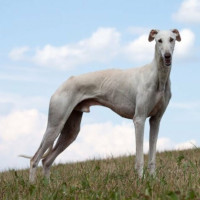 |
Old Croatian Sighthound |
|
He is not recognized by the F.C.I. |
Origin |
Croatia | |
Translation |
Francis Vandersteen | |
This breed is also known as |
Staro-Hrvatski Hrti |
A brief presentation of the Old Croatian Sighthound |
| Descended directly from the Old Bosnian Sighthound, the Staro-Hrvatski Hrti was also strongly influenced by the Hungarian Sighthound, the Posavac Hound, the Istrian Hound and the variety of Sighthounds imported from the West, principally the English Sighthound, the Whippet and the Italian Sighthound. One theory suggests that the Old Croatian Sighthound is the first ancestor of the ancient Dalmatian, but this belief requires further research, given that many breeds were involved in the creation of the popular spotted dog. Although Sighthounds have been used for thousands of years in the Balkans, the Croatian Sighthound is a relatively young breed compared to its Serbian and Bosnian cousins. It was developed in the late 1700s and remained fairly uniform in type until the 20th century. Common crosses with English, Bosnian and modern Dalmatian Hounds, as well as Austrian and German hunting dogs, were made by hunters in Istria, Slavonia and Dalmatia. Some believe that the Old Croatian Sighthound was a distinct breed, closer to Serbian and Hungarian dogs than to the Croatian Greyhound, but the variety almost died out during the Second World War before the surviving strains were assimilated into the Staro-Hrvatski Hrt population. |
History of the Old Croatian Sighthound |
| The recent report (Bauer & Lemo, December 2008), which contains the history of a preserved core of a regional Sighthound, the hrti, or Old Croatian Sighthound, is a remarkable cynological and veterinary contribution to the history of the Sighthound. It is further confirmation of the mechanism behind the extinction of Sighthound varieties, where the loss of aristocratic, landed hunting rights (pursued mainly by horses and hounds) gave way to universal, licensed hunting rights (pursued mainly on foot) , with a firearm) which tended to literally ban Sighthounds. Sighthounds, which by definition require large tracts of open land, became an object of suspected poaching and were often actively persecuted. As a result, regional and national varieties, which had been prolific across Europe for centuries, were eradicated or left to die out. The Chort, Agar Magyar and Chart, for example, escaped this fate, but the Friesian Greyhound did not. Where the national breed and dog clubs actively promoted greyhound herd books, and where a strong racing culture was present, greyhounds such as the Galgo survived. In some cases, as in the latter, and as Bauer and Lemo point out in relation to the law, the Sighthound's regional identity can be compromised by outcrossing with sighthounds or other breeds. |
Appearance of the Old Croatian Sighthound |
| The type is a pink-eared, short-haired sighthound, mainly white in color, with black or dark brown to yellowish patches. Males reach 60-70 cm in height, females 5-10 cm less. The coat is short and flat, white in color, with black, gray, brown or brindle patches of varying sizes on the head and body. Historically, the breed was confirmed as a Greyhound through its use in coursing and has been preserved to this day with occasional crosses with English Greyhounds, other Greyhounds and other breeds. |
Temperament of the Old Croatian Sighthound |
| The Croatian Sighthound is a very agile and fast breed, traditionally used for small game hunting and racing. The breed became very rare in the second half of the 20th century and, before the outbreak of the wars in Yugoslavia, plans were put in motion for a revival program, but were unfortunately never finalized. |
Needs and activities of the Old Croatian Sighthound |
| The breed can still sometimes be seen in parts of present-day Croatia, but the majority of these dogs are working crosses, mainly with the very popular English Greyhound and Istrian Sighthound. In their desire to save the Staro-Hrvatski Hrt from extinction, overzealous farmers in Croatia largely perpetuate the myth that the Bosnian Greyhound is in fact the same breed as the Croatian Greyhound, angering many dog enthusiasts in the Balkans and serious dog authorities worldwide. The two breeds are certainly related, but their developments over the centuries have taken them in different directions. The Croatian breed has become smaller, lighter and calmer than its ancient Bosnian ancestor. The Staro-Hrvatski Hrt is a well-muscled, deep-chested and agile breed, apparently faster than the Bosnian Greyhound, but not as trained or powerful. A capable hunter, this breed also makes a loving, obedient companion, thanks to its intelligence, gentle nature and calm temperament. |
Maintenance of the Old Croatian Sighthound |
| The Old Croatian Sighthound requires minimal grooming. A seasonal flea treatment is necessary, but it is not necessary to have the dog's hair cut by a professional groomer. Ears and eyes should be cleaned from time to time to avoid infections. The Croatian Greyhound is one of the best choices if you don't have the time, skills or money to look after a high-maintenance dog. Regular brushing reduces shedding. Bathing is good for your dog in more ways than one. It's also a good time to look for scratches, bumps, fleas and other unusual irregularities. When the hair is wet and pressed against the body, these details are more visible. Old Croatian greyhounds do not mix well with allergy sufferers, as they provoke allergic reactions. |






 English (United Kingdom)
English (United Kingdom)